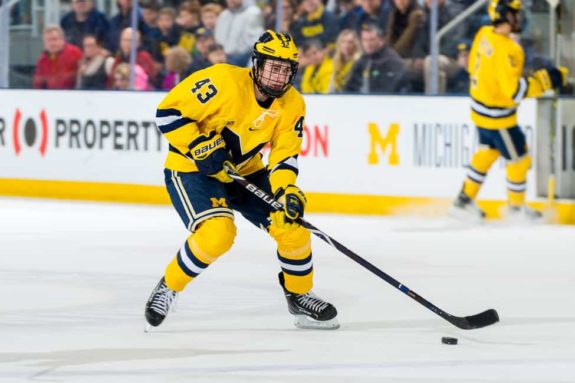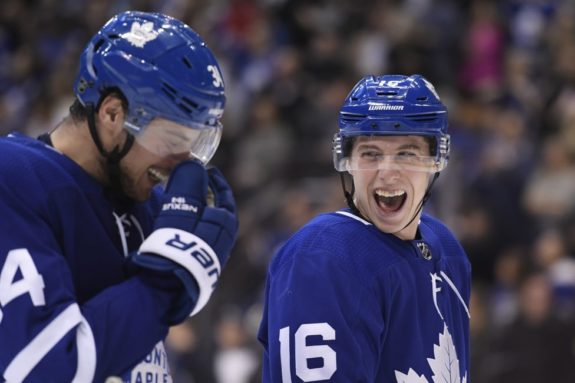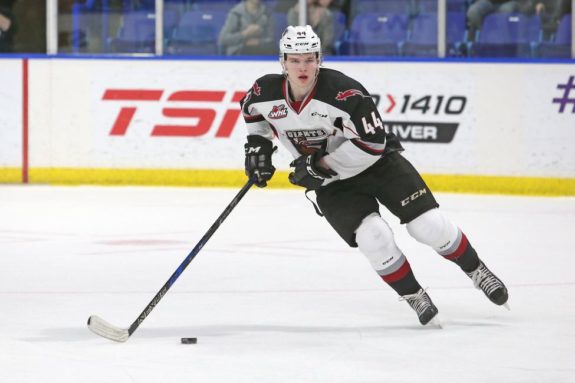As we approach the All-Star break, the Western Conference playoff race is a mess. By “mess,” I mean extremely tight and unpredictable, so perhaps “chaotic” is a better word. As of Jan. 21, just five points separate the first Wild Card team — right now the Dallas Stars — from the 13th-place St. Louis Blues.
In that cluster of teams are the Vancouver Canucks with 52 points, which is just good enough to be inside the playoff picture. While their 23-21-6 record is ordinary, they are an impressive 12-5-3 in their last 20 games, five of which were without star rookie Elias Pettersson who returned on Sunday and registered two points in a 3-2 win.
There’s no denying this situation is surprising. After all, it’s not just a 10 or 20-game sample. After 50 games the Canucks are right in the mix. It may be premature with 32 games left, but I understand when the media pulls out the “P” word, as they did over the weekend.
https://twitter.com/TSN1040/status/1086759170546765824
As hopeful as things might seem, especially with Pettersson healthy again, the 55 percent of people who think the Canucks making the playoffs would be a positive development are wrong.
Canucks Roster Littered With Holes
It is in the Canucks’ best interest to miss the playoffs because their roster isn’t good, at all. This season, they’ve generated the second-fewest shot attempts (CF) in the NHL. Only the New York Rangers’ 43.49 CF/60 is less than the Canucks’ 44.81. The Canucks’ CF percentage is also in the bottom-five of the league, at 47.14 percent.
Vancouver also has the eighth-highest difference between expected Goals For percentage (xGF%) and actual Goals For percentage (GF%), at 2.61 percent, which means they should be scoring less based on the amount of offence they’ve created (expected goals does account for quality, something CF% does not).
Now, let’s look at the Canucks on an individual basis instead of a team one.

It’s clear that most of the forwards on the Canucks are part of the offensive shortcomings. If you’re above the x-axis on this chart, it means you’re producing (measured in points/60 minutes). Obviously, Pettersson has been extremely productive during his short time in the NHL. His 3.35 points per-60 (P/60) ranks third in the NHL (minimum 200 minutes played).
The majority of the forwards on the Canucks sit below that x-axis, meaning Pettersson and Brock Boeser have been pretty much the only “productive” forwards. According to Corsica Hockey, 144 NHLers this season have produced 1.8 P/60 or more. The Canucks have two of those 144 (Pettersson and Boeser at 1.95). The Canucks lack talent. Not just elite talent, but difference-makers.
So how do the Canucks get better on paper?
NHL Entry Draft Best Way to Become Contender
The best way to fix things long-term is to stock the pipeline by drafting well. If the Canucks had an incredibly strong farm team, I wouldn’t be averse to making the playoffs, but they don’t.
On the blue line, they have one blue-chip prospect in Quinn Hughes, but up front, there isn’t anyone with that kind of potential. The only Canucks players other than Hughes to make TSN’s list of the top-50 NHL-affiliated prospects was Adam Gaudette, at 41, and goaltender Thatcher Demko, at 46.

After Vancouver’s 3-2 win over the Detroit Red Wings on Sunday, Red Wings head coach Jeff Blashill was asked about his team’s rebuild. He said you need “elite players” to get back in the playoff picture:
“You probably have to get to three [elite players] to be a playoff team,” Blashill told Jason Botchford of The Athletic. “You probably have to get to four or five to be a real Stanley Cup contender,” (from ‘The Athletties: Why Roussel celebrated, EP’s return, a rebuild debate and what Hughes needs to do’ – The AthleticNHL – 1/20/19).
Assuming Hughes comes as advertised, including him with Pettersson and Boeser, as “elite players” still isn’t enough to push the Canucks into contender status two or three seasons down the line. It’s essential that the Canucks pick in the top-five of this year’s NHL Entry Draft.
2019 NHL Draft Opportunity to Add Elite Talent
The best players are usually the highest draft picks. This is obviously not always the case. Nikita Kucherov, Johnny Gaudreau and Brayden Point were all picked outside the top-50 in their draft years and each is in the top-10 in league scoring. However, 13 of the top-16 scorers in the NHL are former top-10 picks and 16 of the top-20 scorers are first-round selections.

For the Canucks to add another elite talent to their roster, they need a high pick. To get a high pick, they need to finish near the bottom of the standings.
Taking a quick glance at our own Ryan Pike’s list of the top 75 players for the upcoming draft, it’s possible the Canucks could get what they need even if they don’t pick in the top-two. Right now, Jack Hughes and Kaapo Kakko have separated themselves from the rest of the pack, but forwards Dylan Cozens, Kirby Dach or Vasili Podkolzin would be huge building blocks for the organization as well and are likely to go in the top-five.
As hard as it has been for the Canucks to generate offence this season, it’s also clear the blue line needs work. Even after they add Hughes and Olli Juolevi from the farm, and even if they retain Alex Edler, it’s still not enough. Perhaps they should target Bowen Byram or Philip Broberg in June instead of a forward, both could also go in the top-five.

If the Canucks keep winning and qualify for the postseason, the highest they can pick is 16th overall. Picking in the top-five, or even top-10, instead of 16th will make the Canucks a much stronger team in the future.
Isn’t a future with more elite talent, one where the Canucks can contend for an extended period of time better, than sneaking into the playoffs, only to be swept up by the Winnipeg Jets or Nashville Predators? I’d say so.